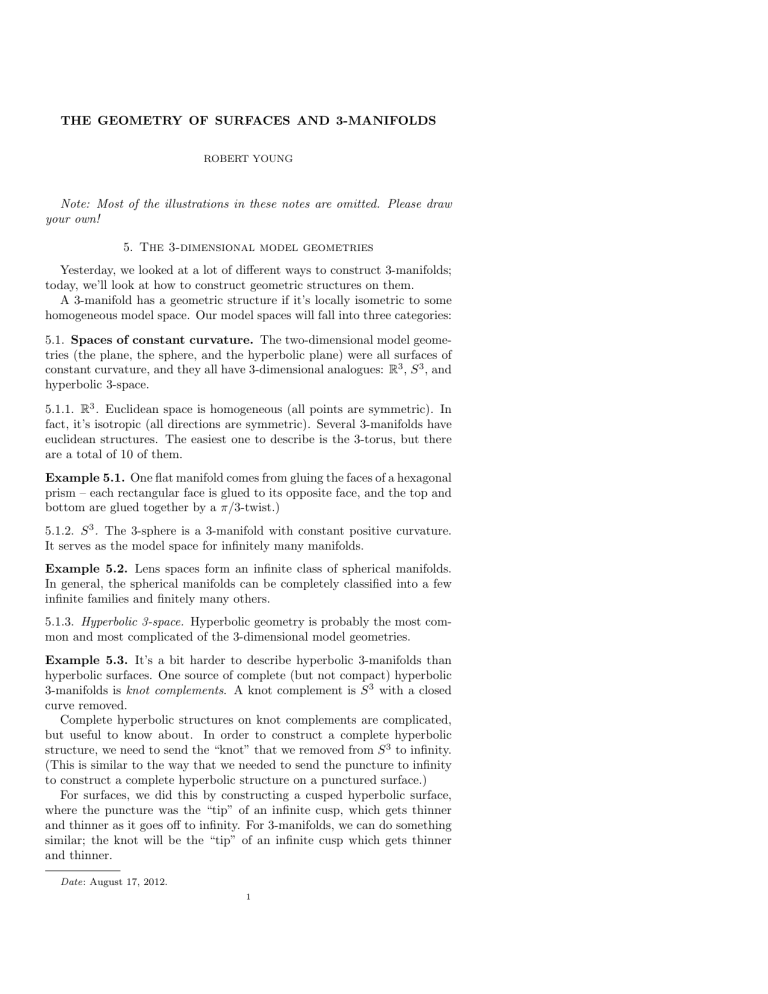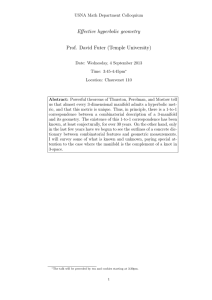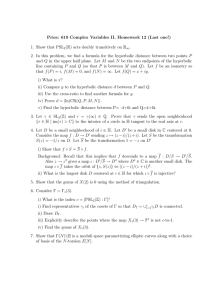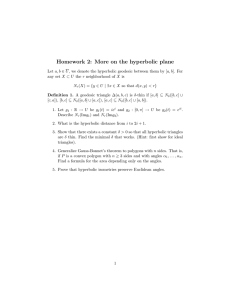THE GEOMETRY OF SURFACES AND 3-MANIFOLDS

THE GEOMETRY OF SURFACES AND 3-MANIFOLDS
ROBERT YOUNG
Note: Most of the illustrations in these notes are omitted. Please draw your own!
5.
The 3-dimensional model geometries
Yesterday, we looked at a lot of different ways to construct 3-manifolds; today, we’ll look at how to construct geometric structures on them.
A 3-manifold has a geometric structure if it’s locally isometric to some homogeneous model space. Our model spaces will fall into three categories:
5.1.
Spaces of constant curvature.
The two-dimensional model geometries (the plane, the sphere, and the hyperbolic plane) were all surfaces of constant curvature, and they all have 3-dimensional analogues:
R
3
, S
3
, and hyperbolic 3-space.
5.1.1.
R
3 .
Euclidean space is homogeneous (all points are symmetric). In fact, it’s isotropic (all directions are symmetric). Several 3-manifolds have euclidean structures. The easiest one to describe is the 3-torus, but there are a total of 10 of them.
Example 5.1.
One flat manifold comes from gluing the faces of a hexagonal prism – each rectangular face is glued to its opposite face, and the top and bottom are glued together by a π/ 3-twist.)
5.1.2.
S 3 .
The 3-sphere is a 3-manifold with constant positive curvature.
It serves as the model space for infinitely many manifolds.
Example 5.2.
Lens spaces form an infinite class of spherical manifolds.
In general, the spherical manifolds can be completely classified into a few infinite families and finitely many others.
5.1.3.
Hyperbolic 3-space.
Hyperbolic geometry is probably the most common and most complicated of the 3-dimensional model geometries.
Example 5.3.
It’s a bit harder to describe hyperbolic 3-manifolds than hyperbolic surfaces. One source of complete (but not compact) hyperbolic
3-manifolds is knot complements . A knot complement is S 3 with a closed curve removed.
Complete hyperbolic structures on knot complements are complicated, but useful to know about. In order to construct a complete hyperbolic structure, we need to send the “knot” that we removed from S
3 to infinity.
(This is similar to the way that we needed to send the puncture to infinity to construct a complete hyperbolic structure on a punctured surface.)
For surfaces, we did this by constructing a cusped hyperbolic surface, where the puncture was the “tip” of an infinite cusp, which gets thinner and thinner as it goes off to infinity. For 3-manifolds, we can do something similar; the knot will be the “tip” of an infinite cusp which gets thinner and thinner.
Date : August 17, 2012.
1
2 ROBERT YOUNG
What does this cusp look like? There’s a model of hyperbolic 3-space which is frequently used to study cusps like this, called the upper halfspace model (figure omitted). In this model, translations in the xy -plane are isometries; if we take the quotient of the upper half-space model by two independent translations, we get a cusp. This is what cusps in hyperbolic
3-manifolds look like; they have tori as cross sections (just like the boundary of a neighborhood of a knot is a torus), and these tori shrink exponentially as one goes further out along the cusp.
5.2.
Product geometries.
These are mostly pretty simple:
5.2.1.
S 2 ×
R
.
This is a pretty simple geometry, and there are only 4 compact manifolds with an S 2 ×
R
-geometric structure.
Example 5.4.
We can list the four manifolds: S
2 formed by adding a twist to S
2 × S
1
, P
2 × S
1
× S
1
, a “Klein bottle”
(the projective plane times a circle), and P 3 # P 3 (the connected sum of two copies of projective space).
5.2.2.
R
2 ×
R
.
This one doesn’t count – it’s the same as
R
3 .
5.2.3.
H 2 ×
R
.
There are infinitely many compact manifolds with an H structure (for instance, Σ ×
R when Σ is a hyperbolic surface.)
2 ×
R
-
Example 5.5.
One non-trivial example is a mapping torus for a surface of genus 2: we can embed the surface of genus 2 in
R
3 so that it’s symmetric under a rotation of order 3. Consider the mapping torus of this map – it has an H 2 ×
R
-structure
5.3.
Geometries of torus bundles.
A mapping torus for the torus comes from a map from the torus to itself. If we consider a square torus, any map from the torus to itself can be straightened into a “linear” map. That is, it can be replaced by a map which comes from a linear transformation of the plane. In fact, it has to come from a matrix
M = a b c d with a, b, c, d integers and ad − bc = ± 1.
If X is the resulting mapping torus, it’s a torus bundle. We’ll put a geometric structure on X so that each torus in X is a flat torus; the exact geometric structure will depend on the eigenvalues of M . (Since M has determinant ± 1, we know that the eigenvalues have product ± 1.)
5.3.1.
M has complex eigenvalues.
The eigenvalues of M have to have norm
1, so some power of M is the identity. In this case, there’s some flat torus such that M acts as an isometry of that flat torus. If we use this torus to construct X , X gets a flat structure (see the example for
R
3 for an example where M has order 6).
5.3.2.
M has two distinct positive eigenvalues.
Example 5.6.
Take
M =
2 1
1 1
.
Let’s look at the mapping torus. We get this mapping torus by gluing opposite sides of a cube, and gluing the top face to the bottom by a linear map which looks like (figure omitted). Let’s say the bottom face is square, or at least close to square. Since the top face and the bottom face are identified, we can reconstruct what the structure on the top face has to be to match up (figure omitted). In between, we need some sort of smooth
THE GEOMETRY OF SURFACES AND 3-MANIFOLDS 3 transition between the top and bottom.
We can get this transition by stretching one direction while squashing another.
In this case, X has a Sol-structure. Sol is typically represented as a metric on
R
3
. Normally, the integral for the length of a curve γ ( t ) looks like:
Z
L = q
γ 0 x
( t ) 2 + γ 0 y
( t ) 2 + γ 0 z
( t ) 2 dt, where x, y, and z are treated symmetrically. In Sol, the integral looks like:
L =
Z q e − 2 z γ 0 x
( t ) 2 + e 2 t γ 0 y
( t ) 2 + γ 0 z
( t ) 2 dt.
z is unchanged, but the size of the x -direction and the y -direction depends on z .
In particular, the shortest path from (0 , 0 , 0) to ( e 10 , 0 , 0) isn’t along the x -axis. It’s much shorter to go from (0 , 0 , 0) to (0 , 0 , 10) (10 units), then
( e 10 , 0 , 10) (1 unit), then ( e 10 , 0 , 0) (10 units).
The symmetries for Sol stretch and squish the x and y axes – if you translate everything up by c , you need to squash x by e c e
− c .
and stretch y by
5.3.3.
M has eigenvalue 1 with multiplicity 2.
Example 5.7.
Take
M =
1 1
0 1
.
We can do the same thing as before, but now, instead of needing to squash and stretch to link the top and bottom, we need to skew. The resulting geometry is called Nil.
One way of looking at this geometry involves a contact structure . At each point in
R
3
, we put a plane; in the x direction, the plane is horizontal, and in the y direction, it slopes up with slope x . Consider the curves that are tangent to these planes, and let the length of a curve be the length of its projection to the xy -plane. This is approximately Nil-geometry: translating in the x direction and tilting preserves all the planes, and you can use translations like that to express X as a quotient of Nil.
This is an unusual geometry. Since none of the planes are tangent to the z -axis, you can’t go straight up. Instead, to change z , you have to move in a circle in the xy -plane; it’s sort of like a spiral staircase.
One way to think about this is that it’s what your front wheels do when you parallel park – the front wheels can move forward or backward and turn left or right, so they have two degrees of freedom (a plane). But by combining motions (left, forward, right, backward), they move in a third direction.
5.4. Nil -like (contact) geometries.
Nil-geometry points out a pattern in the model geometries – in Nil, paths moving in the xy -plane lead to motion in the z -direction. We can do the same thing for paths in the sphere and the hyperbolic plane:
5.4.1.
S 2 .
This is essentially the same geometry as S 3 .
5.4.2.
R
2 .
This is Nil.
4 ROBERT YOUNG
5.4.3.
H 2 .
This gives rise to something new! In fact, this is a geometry on
T
1
H 2 .
One way to think about this is that if you have a vector on H 2 and slide it around the hyperbolic plane, the curvature of the plane causes the vector to change. This is a geometry that takes account of that change; it’s the model geometry that gives a structure on T
1
Σ when Σ is a hyperbolic surface.
6.
Putting them all together: Thurston-Perelman
Geometrization
In general, not every 3-manifold has a geometric structure. For example, take the connected sum of two 3-tori. The genus 2 surface has a hyperbolic structure, but not the connected sum of two 3-tori – the problem is that when you take the universal cover of the connected sum, you get a complicated space consisting of copies of
R
3 connected by spherical tubes (i.e., products of spheres and intervals). In general, in order to get a geometric structure on a 3-manifold, you need to break it up into pieces.
The Geometrization Theorem says you can do exactly that:
Theorem 6.1
(Thurston-Perelman) .
Every orientable closed 3-manifold can be cut along tori and spheres so that after you fill in the spheres with balls, each piece has a complete geometric structure with finite volume.
So, to get a geometric structure on the connected sum of 3-tori, you cut them apart, fill in the hole, and get Euclidean structures on each piece.
In general, you might need to cut along tori to get a geometric structure
– for instance, knot complements all have a torus as their boundary, so we can glue them together. The resulting manifold doesn’t have a geometric structure, but the pieces do.
which states:
Conjecture 6.2.
Every simply connected, closed 3-manifold is homeomorphic to the 3-sphere.
This is a consequence of the Geometrization Theorem (in fact, geometrization was developed partly in order to solve the Poincar´ X is simply connected, there aren’t any good tori or spheres to cut along, so X itself must have a geometric structure. The only simply-connected manifold with a geometric structure is the 3-sphere.
7.
Further reading
A good (though advanced) introduction to the 3-dimensional model geometries can be found in William Thurston’s book “Three-dimensional geometry and topology.” (Edited by Silvio Levy).
More details on precisely which manifolds have which geometric structures can be found in Peter Scott’s paper “The geometries of 3-manifolds.”




